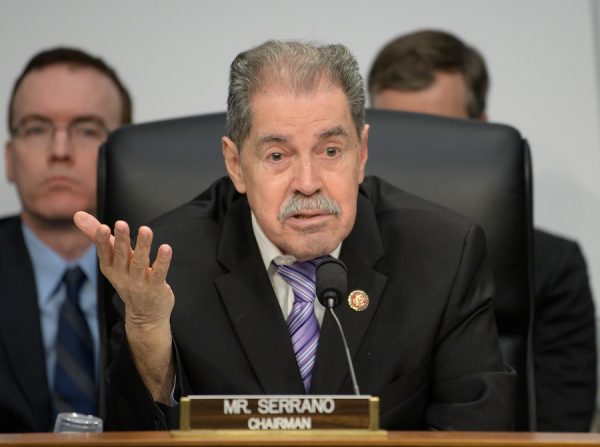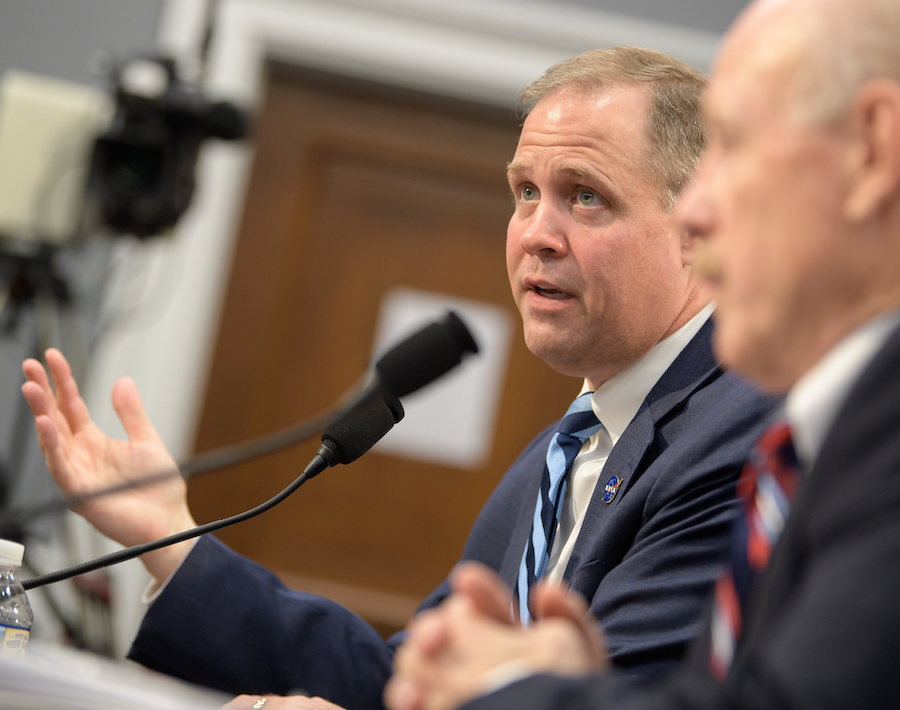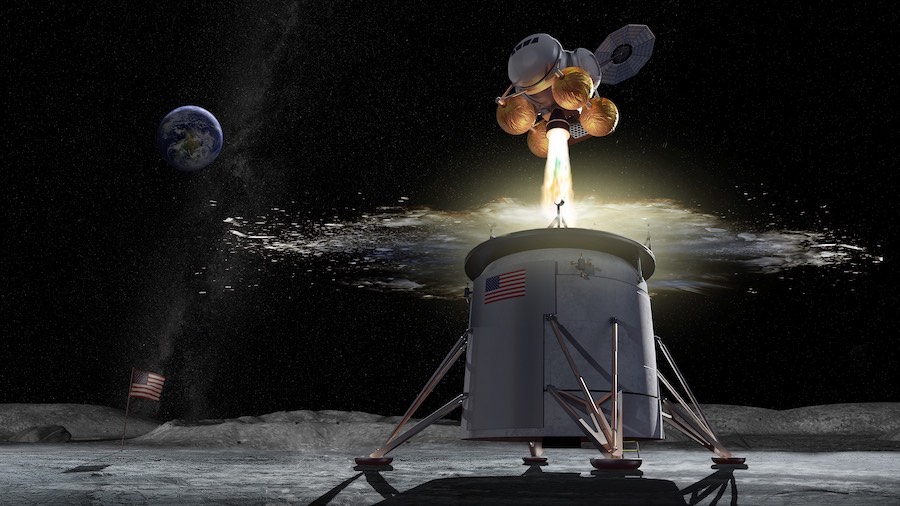Lawmakers question NASA’s plan for a 2024 moon landing – Spaceflight Now

Amid questions from lawmakers about the cost of the Trump administration’s proposal to accelerate a human return to the moon’s surface to 2024, the chairman of the House subcommittee responsible for helping write NASA’s budget said this week he favors keeping to the space agency’s earlier schedule for a crewed lunar landing by 2028.
“I remain extremely concerned by the proposed advancement by four years of this mission,” said Rep. José Serrano, D-New York. “The eyes of the world are upon us. We cannot afford to fail. Therefore, I believe that it is better to use the original NASA schedule of 2028 (for a human landing on the moon) in order to have a successful, safe and cost-effective mission for the benefit of the American people and the world.”
Serrano made the comments during a hearing Wednesday before the House Appropriations Committee’s subcommittee on commerce, justice, science and related agencies. He chairs the budget-writing subcommittee, which sets House funding marks for multiple federal agencies, including NASA.
Under direction from the Trump administration, NASA is pursuing a fast-track moon program named Artemis — the twin sister of Apollo in Greek mythology — to put the first woman and the next man on the moon by the end of 2024.
“While all of us on this subcommittee would like see the first woman astronaut into deep space, including to the surface of the moon, we want to do it in a responsible way from the perspective of safety, cost and likelihood of mission success,” Serrano said.
NASA has not released an official cost estimate for accelerating the moon landing timeline by four years. Lawmakers pressed NASA Administrator Jim Bridenstine for a budget during Wednesday’s hearing, but he said the numbers will be not be released until February, when the White House submits its next budget request to Congress.
Bridenstine told CNN in June that accomplishing a landing on the moon with astronauts in 2024 could cost $20 to $30 billion over NASA’s regular funding levels. But a detailed accounting of the costs has not been released.
“I remain extremely concerned about the additional costs to accelerate the mission to the moon by four years,” Serrano said Wednesday. “To date, NASA has not provided the committee with a full cost estimate, despite repeated requests.”

Bridenstine has pledged not to pay for the moon landing program by raiding NASA’s budget for other projects, such as the International Space Station, new space telescopes and interplanetary probes. During Wednesday’s House hearing, Bridenstine — a former congressman from Oklahoma — said cutting NASA’s budget for science or the space station could lead to a “parochial fight” between lawmakers representing key states with a large NASA presence, such as Alabama, Florida and Texas.
“The goal should be additional resources, not cannibalizing one part of NASA to feed another part of NASA,” Bridenstine said.
Serrano said funding the accelerated moon program, assuming its costs are in line with Bridenstine’s earlier comments, would “severely impact vital programs” across the federal government, with the exception of the Defense Department.
“This is not just about finding the money,” Serrano said. “It’s about where this president is known to go find monies when he needs them. If he came to us and said no (border) wall in return for ’24, you might get a few Democrats to agree with that, right? Maybe more than that. But he’s probably going to say lower Pell Grants, lower food stamps, lower education dollars, and that’s not acceptable, and that’s the problem.”
The White House submitted to Congress a request in May for $1.6 billion to cover initial costs to move forward the moon landing schedule to 2024. That funding request was on top of NASA’s $21 billion budget request released in March, before Vice President Mike Pence announced the 2024 moon landing goal.
Trump administration officials said in May they wanted to shift the $1.6 billion, described by Bridenstine as a “down payment” for the 2o24 moon landing, to NASA from surplus money in the Pell Grant program that supports college education for low-income students.
The bulk of the $1.6 billion budget augmentation would pay for the development of new human-rated lunar landers, and for work on NASA’s Space Launch System heavy-lift rocket and Orion crew capsule needed to carry astronauts toward the moon.

The Pell Grant surplus account has grown to nearly $9 billion in recent years, primarily due to declining enrollment in the program, according to the White House budget office. Shifting some of that money elsewhere in the budget would have no impact on students currently receiving Pell Grants, the White House said. But those against the move argue that the surplus is used to fund Pell Grants during times of higher enrollment, such as during an economic recession.
“I don’t want to go to the moon by taking money from people who can’t afford to survive in this society to the level that they should survive in this society,” Serrano said. “That is a big problem that we have to get over — where that money is going to come from.”
Rep. Matt Cartwright, D-Pennsylvania, said Congress needs to know the projected total cost of the Artemis program before committing funding to the moon landing effort. He likened the Trump administration’s request for $1.6 billion to expecting consumer to buy a car while only knowing the cost of the down payment.
“When you go to buy a car, and there’s a car salesman standing there, what do you ask him?” Cartwright said. “You ask him how much is the car, right? And when he comes to you and says, ‘Well it’s only going be $2,000 in the first year,’ you say, ‘Yeah, but I’m asking you how much the car is?’”
“Thats not acceptable,” Cartwright said. “You need to know the total cost.”
Republican lawmakers were more receptive to the Trump administration’s 2024 moon landing goal.
“I strongly support this accelerated 2024 goal, and the Artemis program,” said Rep. Kay Granger, R-Texas, the top Republican on the House Appropriations Committee. “Sending American astronauts, including the first woman, to the south pole of the moon will showcase the global leadership and technological advances of the United States. It will also enhance our national security by allowing us to establish a strategic presence on the moon.”
Rep. Robert Aderholt, R-Alabama, also expressed support for the accelerated moon landing program, and said NASA needs “sustained investment” to meet the 2024 schedule.
NASA has already released a solicitation for companies to propose lunar lander designs that could carry astronauts to the moon’s surface by the end of 2024. The space agency hopes to select four companies to begin detailed studies by January, followed by a down-selection to two companies in late 2020 to proceed with full-scale lander development in time for a 2024 mission.
The fiscal 2020 budget bill passed by the House of Representatives in June did not include the $1.6 billion in extra funding for the Artemis program. An appropriations bill approved by the Senate Appropriations Committee last month proposed $744 million for development of human-rated lunar landers, $256 million short of the $1 billion NASA said it needed just for the landing system.
In response to questions Oct. 3 from industry, NASA officials said a funding shortfall for the lunar lander program could reduce the number of companies it can select for human-rated lunar lander contracts.
At the close of Wednesday’s hearing, Serrano said he supports NASA’s work, but the agency and the White House need to answer questions about the Artemis program’s cost before the House can appropriate taxpayer money for the expedited moon landing effort.
“All those folks that are already writing on Twitter — newspaper clippings already went out when we’re sitting here — (are) saying I just killed the mission. I don’t have the power,” Serrano told Bridenstine. “I didn’t kill the mission. I just asked some questions that I know you know need to be answered before we move forward or not. So I thank you for your work.”
Email the author.
Follow Stephen Clark on Twitter: @StephenClark1.






